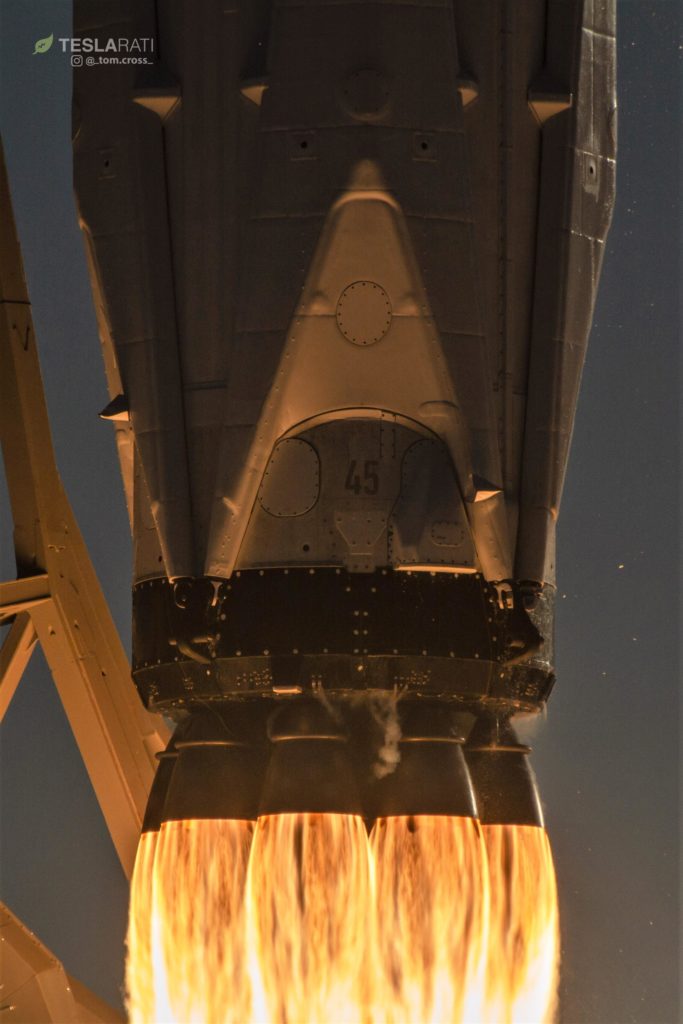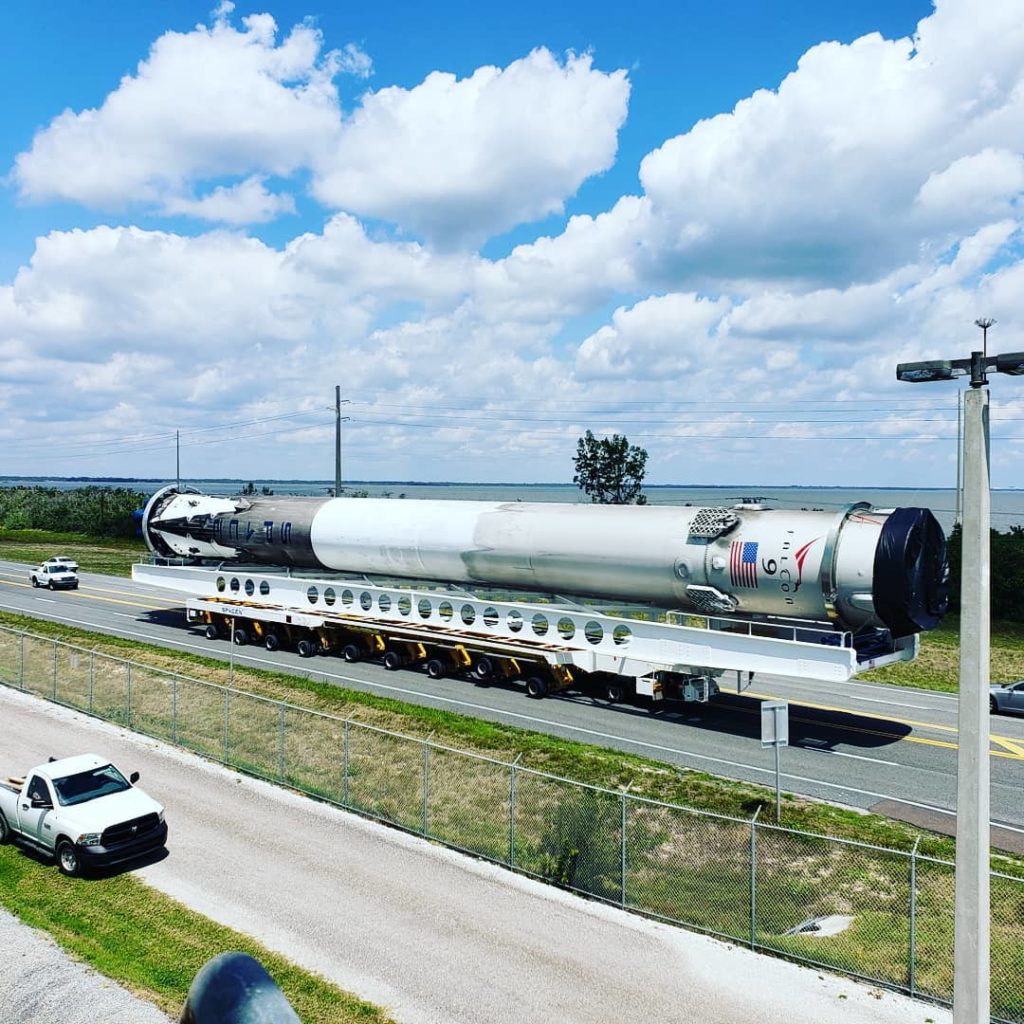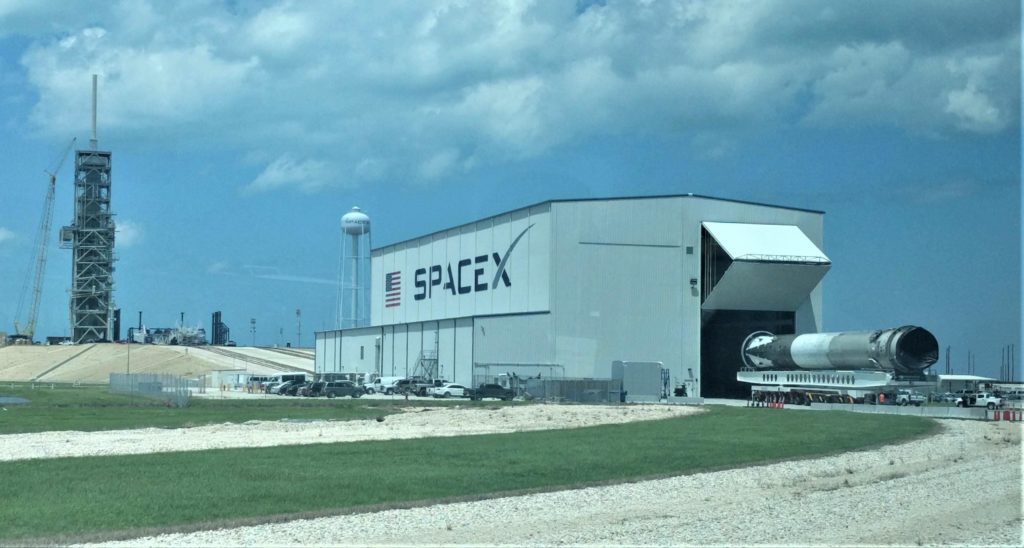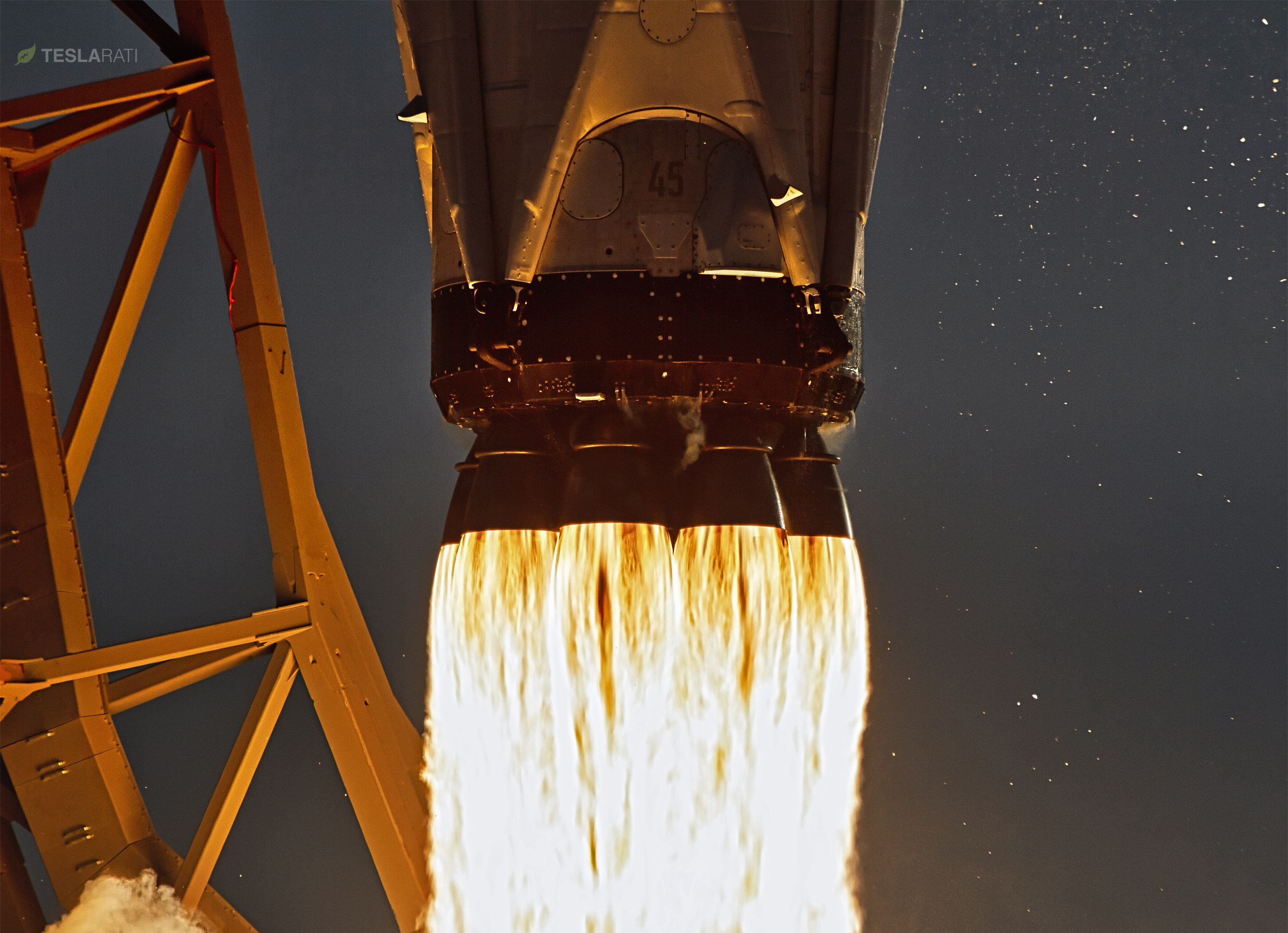
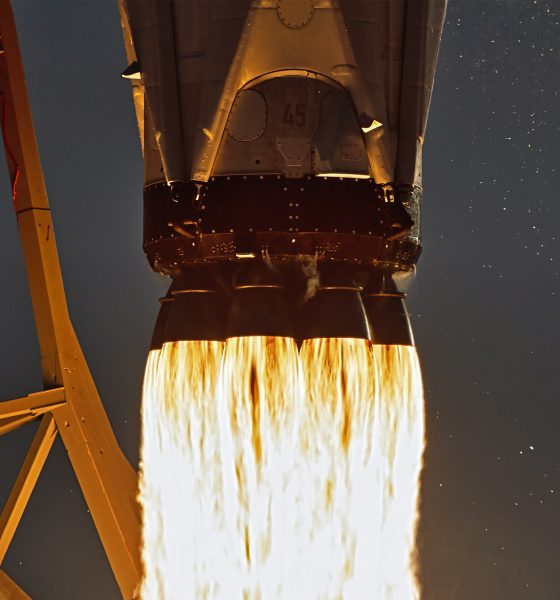
News
SpaceX to ring in Falcon 9 Block 5 future with record-speed Block 4 reuse
SpaceX is days away from effectively bringing to a close an era of moderately reusable Falcon 9s that paved the way for the company’s Block 5 rocket upgrade, designed to dramatically improve reliability and reusability. As if foreshadowing the future its culmination will ring in, the CRS-15 mission will beat SpaceX’s previous record for back-to-back Falcon 9 booster launches by nearly a factor of two.
Scheduled to launch at 5:42 am EDT June 29, the CRS-15 Cargo Dragon mission will be SpaceX’s fourth launch of an orbital, flight-proven spacecraft, and will also cut almost two months off of the Falcon 9 booster refurbishment process. The particular booster, number B1045, launched just two months ago on April 18 before landing aboard SpaceX’s Atlantic drone ship Of Course I Still Love You (OCISLY). After returning to shore, the rocket was transported by road the short few miles from Port Canaveral to Kennedy Space Center and SpaceX’s LC-39A integration facilities, where it is believed to have spent the last nine weeks undergoing moderate repairs, part replacements, and checkouts. Just yesterday, the once-flown booster took to Launch Complex 40 (LC-40) for the second time to complete a preflight static fire, intended to ensure that the rocket is healthy before launch.
Rocket and spacecraft for CRS-15 are flight-proven. Falcon 9’s first stage previously launched @NASA_TESS two months ago, and Dragon flew to the @Space_Station in support of our ninth resupply mission in 2016.
— SpaceX (@SpaceX) June 23, 2018
In reality, the actual time available for B1045’s refurbishment was thus several days less than two months – the only other routinely reusable rocket, the Space Shuttle, lays claim to a fairly staggering record of just 26 days of actual refurbishment, although it’s worth considering the fact that a single one of the Shuttle’s 3 RS-25 rocket engines have been estimated to cost as much as $60 million, considerably more than two thirds of the price of an entire SpaceX mission for NASA.
Although CRS-15 will likely see its venerable Block 4 Falcon 9 booster expended in the ocean without a recovery attempt, the speed of Falcon 9 B1045’s refurbishment is thrilling for another, more abstract reason: if the design functions largely as intended, a Falcon 9 Block 5 booster should be able to handily crush that already impressive record with ease, and one will perhaps do just that within a handful of months of this launch.
Currently scheduled for no earlier than (NET) July 19 and late July to early August, the Telstar 19V and 18V communications satellites will require their own Block 5 launches roughly a month from today, and July 20’s Iridium NEXT-7 mission will further require its own Falcon 9 Block 5 booster for a mission from California. It remains to be seen what boosters will launch those three missions, as well as an additional two SpaceX missions tentatively scheduled for August and September.
- After launching in April 2018, B1045 landed on OCISLY and is being refurbished for a second launch in just 5 days, on June 29. (Tom Cross)
- Falcon 9 B1045 spied in transport from Port Canaveral to LC-39A, April 24. (Instagram /u/xxxtreme81)
- B1045 enters SpaceX’s 39A integration and refurbishment facilities, April 24. (Reddit /u/NewRage)
Of note, those upcoming July launches will see both of SpaceX’s drone ships – Just Read The Instructions (JRTI) on the Pacific, OCISLY in the Atlantic – return to action, with JRTI’s return bringing to an end nearly a full year of inactivity. With a heavy summer and fall manifest of all Block 5 Falcon 9s just around the corner, both drone ships are likely to be busier than ever before. Teslarati photographers Tom Cross (Florida) and Pauline Acalin (California) will be there to document the flurry of launches and recoveries on both coasts over the busy second half of 2018.

The drone ship Of Course I Still Love You spotted in Port Canaveral, FL last December. (Instagram /u/ johnabc123)
Follow us for live updates, peeks behind the scenes, and photos from Teslarati’s East and West Coast photographers.
Teslarati – Instagram – Twitter
Tom Cross – Twitter
Pauline Acalin – Twitter
Eric Ralph – Twitter

Elon Musk
Elon Musk’s X will start using a Tesla-like software update strategy
The initiative seems designed to accelerate updates to the social media platform, while maintaining maximum transparency.

Elon Musk’s social media platform X will adopt a Tesla-esque approach to software updates for its algorithm.
The initiative seems designed to accelerate updates to the social media platform, while maintaining maximum transparency.
X’s updates to its updates
As per Musk in a post on X, the social media company will be making a new algorithm to determine what organic and advertising posts are recommended to users. These updates would then be repeated every four weeks.
“We will make the new 𝕏 algorithm, including all code used to determine what organic and advertising posts are recommended to users, open source in 7 days. This will be repeated every 4 weeks, with comprehensive developer notes, to help you understand what changed,” Musk wrote in his post.
The initiative somewhat mirrors Tesla’s over-the-air update model, where vehicle software is regularly refined and pushed to users with detailed release notes. This should allow users to better understand the details of X’s every update and foster a healthy feedback loop for the social media platform.
xAI and X
X, formerly Twitter, has been acquired by Elon Musk’s artificial intelligence startup, xAI last year. Since then, xAI has seen a rapid rise in valuation. Following the company’s the company’s upsized $20 billion Series E funding round, estimates now suggest that xAI is worth tens about $230 to $235 billion. That’s several times larger than Tesla when Elon Musk received his controversial 2018 CEO Performance Award.
As per xAI, the Series E funding round attracted a diverse group of investors, including Valor Equity Partners, Stepstone Group, Fidelity Management & Research Company, Qatar Investment Authority, MGX, and Baron Capital Group, among others. Strategic partners NVIDIA and Cisco Investments also continued support for building the world’s largest GPU clusters.
News
Tesla FSD Supervised wins MotorTrend’s Best Driver Assistance Award
The decision marks a notable reversal for the publication from prior years, with judges citing major real-world improvements that pushed Tesla’s latest FSD software ahead of every competing ADAS system.

Tesla’s Full Self-Driving (Supervised) system has been named the best driver-assistance technology on the market, earning top honors at the 2026 MotorTrend Best Tech Awards.
The decision marks a notable reversal for the publication from prior years, with judges citing major real-world improvements that pushed Tesla’s latest FSD software ahead of every competing ADAS system. And it wasn’t even close.
MotorTrend reverses course
MotorTrend awarded Tesla FSD (Supervised) its 2026 Best Tech Driver Assistance title after extensive testing of the latest v14 software. The publication acknowledged that it had previously criticized earlier versions of FSD for erratic behavior and near-miss incidents, ultimately favoring rivals such as GM’s Super Cruise in earlier evaluations.
According to MotorTrend, the newest iteration of FSD resolved many of those shortcomings. Testers said v14 showed far smoother behavior in complex urban scenarios, including unprotected left turns, traffic circles, emergency vehicles, and dense city streets. While the system still requires constant driver supervision, judges concluded that no other advanced driver-assistance system currently matches its breadth of capability.
Unlike rival systems that rely on combinations of cameras, radar, lidar, and mapped highways, Tesla’s FSD operates using a camera-only approach and is capable of driving on city streets, rural roads, and freeways. MotorTrend stated that pure utility, the ability to handle nearly all road types, ultimately separated FSD from competitors like Ford BlueCruise, GM Super Cruise, and BMW’s Highway Assistant.
High cost and high capability
MotorTrend also addressed FSD’s pricing, which remains significantly higher than rival systems. Tesla currently charges $8,000 for a one-time purchase or $99 per month for a subscription, compared with far lower upfront and subscription costs from other automakers. The publication noted that the premium is justified given FSD’s unmatched scope and continuous software evolution.
Safety remained a central focus of the evaluation. While testers reported collision-free operation over thousands of miles, they noted ongoing concerns around FSD’s configurable driving modes, including options that allow aggressive driving and speeds beyond posted limits. MotorTrend emphasized that, like all Level 2 systems, FSD still depends on a fully attentive human driver at all times.
Despite those caveats, the publication concluded that Tesla’s rapid software progress fundamentally reshaped the competitive landscape. For drivers seeking the most capable hands-on driver-assistance system available today, MotorTrend concluded Tesla FSD (Supervised) now stands alone at the top.
News
Elon Musk’s Grokipedia surges to 5.6M articles, almost 79% of English Wikipedia
The explosive growth marks a major milestone for the AI-powered online encyclopedia, which was launched by Elon Musk’s xAI just months ago.

Elon Musk’s Grokipedia has grown to an impressive 5,615,201 articles as of today, closing in on 79% of the English Wikipedia’s current total of 7,119,376 articles.
The explosive growth marks a major milestone for the AI-powered online encyclopedia, which was launched by Elon Musk’s xAI just months ago. Needless to say, it would only be a matter of time before Grokipedia exceeds English Wikipedia in sheer volume.
Grokipedia’s rapid growth
xAI’s vision for Grokipedia emphasizes neutrality, while Grok’s reasoning capabilities allow for fast drafting and fact-checking. When Elon Musk announced the initiative in late September 2025, he noted that Grokipedia would be an improvement to Wikipedia because it would be designed to avoid bias.
At the time, Musk noted that Grokipedia “is a necessary step towards the xAI goal of understanding the Universe.”
Grokipedia was launched in late October, and while xAI was careful to list it only as Version 0.1 at the time, the online encyclopedia immediately earned praise. Wikipedia co-founder Larry Sanger highlighted the project’s innovative approach, noting how it leverages AI to fill knowledge gaps and enable rapid updates. Netizens also observed how Grokipedia tends to present articles in a more objective manner compared to Wikipedia, which is edited by humans.
Elon Musk’s ambitious plans
With 5,615,201 total articles, Grokipedia has now grown to almost 79% of English Wikipedia’s article base. This is incredibly quick, though Grokipedia remains text-only for now. xAI, for its part, has now updated the online encyclopedia’s iteration to v0.2.
Elon Musk has shared bold ideas for Grokipedia, including sending a record of the entire knowledge base to space as part of xAI’s mission to preserve and expand human understanding. At some point, Musk stated that Grokipedia will be renamed to Encyclopedia Galactica, and it will be sent to the cosmos.
“When Grokipedia is good enough (long way to go), we will change the name to Encyclopedia Galactica. It will be an open source distillation of all knowledge, including audio, images and video. Join xAI to help build the sci-fi version of the Library of Alexandria!” Musk wrote, adding in a later post that “Copies will be etched in stone and sent to the Moon, Mars and beyond. This time, it will not be lost.”

